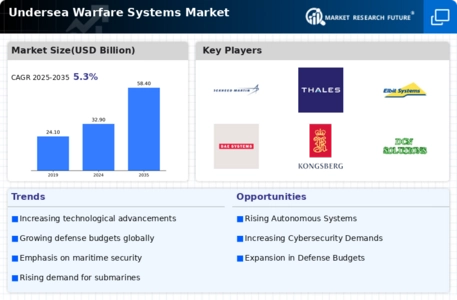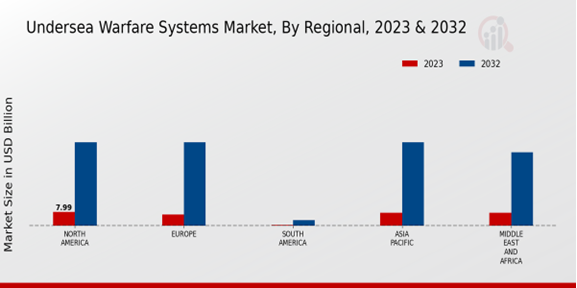Market Growth Projections
The Global Undersea Warfare Systems Market Industry is poised for substantial growth, with projections indicating a market value of 32.9 USD Billion in 2024 and an anticipated increase to 58.4 USD Billion by 2035. This growth reflects a compound annual growth rate (CAGR) of 5.34% from 2025 to 2035. The expansion is driven by various factors, including technological advancements, increasing geopolitical tensions, and the growing demand for maritime security solutions. As nations continue to invest in their naval capabilities, the undersea warfare systems market is expected to evolve, adapting to new challenges and opportunities in the maritime domain.
Expansion of Naval Capabilities
The expansion of naval capabilities among various nations is a crucial driver for the Global Undersea Warfare Systems Market Industry. Countries are increasingly focusing on enhancing their naval forces to address emerging threats in the maritime domain. This includes the development of new submarines, underwater drones, and advanced weapon systems. For instance, several nations are investing in next-generation submarines that incorporate stealth technology and advanced sensors. This trend not only bolsters national defense but also stimulates market growth, as the demand for sophisticated undersea warfare systems continues to rise.
Increasing Geopolitical Tensions
The Global Undersea Warfare Systems Market Industry experiences heightened demand due to rising geopolitical tensions among nations. Countries are increasingly investing in advanced undersea warfare capabilities to secure their maritime interests. For instance, nations like the United States and China are expanding their submarine fleets and enhancing underwater surveillance systems. This trend is expected to drive the market's growth, with projections indicating a market value of 32.9 USD Billion in 2024. The focus on deterrence and defense strategies in contested waters underscores the importance of undersea warfare systems in national security agendas.
Growing Demand for Maritime Security
The Global Undersea Warfare Systems Market Industry is witnessing a surge in demand for maritime security solutions. With the increase in piracy, smuggling, and illegal fishing activities, nations are prioritizing the protection of their maritime domains. This has led to enhanced investments in undersea surveillance and combat systems. Countries are deploying advanced submarines equipped with state-of-the-art technologies to monitor and secure their waters. The emphasis on safeguarding maritime trade routes further propels the market, as nations recognize the strategic importance of undersea warfare capabilities in maintaining national security.
Technological Advancements in Undersea Systems
Rapid technological advancements are significantly influencing the Global Undersea Warfare Systems Market Industry. Innovations in sonar technology, autonomous underwater vehicles, and advanced weaponry are enhancing operational capabilities. For example, the integration of artificial intelligence in underwater systems allows for improved data analysis and decision-making. These advancements not only increase the effectiveness of undersea operations but also reduce operational costs. As nations seek to modernize their fleets, the market is projected to grow at a CAGR of 5.34% from 2025 to 2035, reaching an estimated value of 58.4 USD Billion by 2035.
Environmental Considerations in Undersea Warfare
Environmental considerations are becoming increasingly relevant in the Global Undersea Warfare Systems Market Industry. As nations develop undersea warfare systems, there is a growing awareness of the potential ecological impacts of military operations. This has led to the adoption of more environmentally friendly technologies and practices in the design and deployment of undersea systems. For example, the use of quieter submarines and non-toxic materials in construction is gaining traction. This shift not only addresses environmental concerns but also aligns with international regulations, potentially influencing procurement decisions in the market.




















